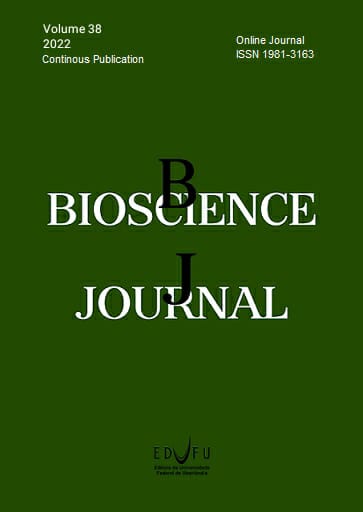Biocontrol potential of Beauveria bassiana and Metarhizium anisopliae isolates from Turkey against Hyphantria cunea (Drury) (Lepidoptera: arctiidae) Larvae under laboratory and field conditions
DOI:
https://doi.org/10.14393/BJ-v38n0a2022-60197Palavras-chave:
Entomopathogenic Fungi, Fall Webworm, Insecticidal Activity, Microbial Control, Pest Insect.Resumo
Hyphantria cunea is one of the most important pest insects causing significant damage in many plant species. The present study aimed to evaluate the insecticidal activity of Turkey isolates of Beauveria bassiana and Metarhizium anisopliae against H. cunea larvae under laboratory and field conditions. B. bassiana isolates YK16, YK23 and YK26, and M. anisopliae isolates YK41 and YK45 were sprayed onto the larvae of H. cunea at the respective doses of 1x105 and 1x106 conidia mL-1 and monitored for seven days. Fungal isolates, bio-insecticide Bacillus thuringiensis and chemical insecticide diflubenzuron were used in field studies. Trials were carried out in five replications. All B. bassiana isolates caused 100% mortality on first instar larvae in laboratory trials. Mortality ratios ranged from 100 to 96% on second instar larvae. M. anisopliae isolates YK45 and YK41 caused 88 and 84%, and 81.33 and 77.11% mortalities for the first and second instar larvae, respectively. The mortality rates fluctuated between 91.78-72.89% for B. bassiana on third instar larvae in laboratory conditions. However, M. anisopliae isolates YK45 and YK41 caused 77.11 and 60.22% mortality on third instar larvae, respectively. In the field trials, B. bassiana YK23 displayed promising insecticidal activity with 80.60% mortality on second instar larvae of H. cunea. Other isolates as well caused mortalities ranging from 60.77 to 49.55%. The results revealed that some isolates of B. bassiana and M. anisopliae have potential to control H. cunea larvae. However, additional detailed studies need to be carried out to increase their effectiveness in field conditions.
Downloads
Referências
ABBOTT, W.S. A method for computing the effectiveness of an insecticide. Journal of Economic Entomology.1925, 18, 265–267. https://doi.org/10.1093/jee/18.2.265a
AGBOYI, L.K., et al. Improving the efficiency of Beauveria bassiana applications for sustainable management of Plutella xylostella (Lepidoptera: Plutellidae) in West Africa. Biological Control. 2020, 144, 104233. https://doi.org/10.1016/j.biocontrol.2020.104233
AKER, O. and TUNCER, C. Efficacy of Metarhizium anisopliae and some entomopathogenic fungi on larvae of fall webworm, Hyphantria cunea (Drury) (Lepidoptera: Arctiidae). Journal of Entomology and Zoology Studies. 2016, 4(5), 171–176.
ARMAS, A.D.L.C., et al. Beauveria bassiana and Metarhizium anisopliae parasitism of fall webworm, Hyphantria cunea Drury larvae. Southwestern Entomologist. 2020, 45(1), 51–56. https://doi.org/10.3958/059.045.0105
BATTA, Y.A. and KAVALLIERATOS, N.G. The use of entomopathogenic fungi for the control of stored-grain insects. International Journal of Pest Management. 2018, 64(1), 77–87. https://doi.org/10.1080/09670874.2017.1329565
BI, Y., et al. An auto-contamination trap-strips system for biological control of Hyphantria cunea (Lepidoptera: Noctuidae), an invasive pest in China. International Journal of Pest Management. 2018, 64(3), 230-235. https://doi.org/10.1080/09670874.2017.1384966
DE FARIA, M.R. and WRAIGHT, S.P. Mycoinsecticides and mycoacaricides: a comprehensive list with worldwide coverage and international classification of formulation types. Biological Control. 2007, 43, 237–256. https://doi.org/10.1016/j.biocontrol.2007.08.001
FITE, T., et al. Evaluation of Beauveria bassiana, Metarhizium anisopliae, and Bacillus thuringiensis for the management of Helicoverpa armigera (Hubner) (Lepidoptera: Noctuidae) under laboratory and field conditions. Biocontrol Science and Technology. 2020, 30(3), 278–295. https://doi.org/10.1080/09583157.2019.1707481
GE, X., et al. Projecting the current and future potential global distribution of Hyphantria cunea (Lepidoptera: Arctiidae) using CLIMEX. Pest Management Science. 2019, 75(1), 160–169. https://doi.org/10.1002/ps.5083
GENCER, D., et al. Genome sequence analysis and organization of the Hyphantria cunea granulovirus (HycuGV-Hc1) from Turkey. Genomics. 2020, 112(1), 459–466. https://doi.org/10.1016/j.ygeno.2019.03.008
GODONOU, I., et al. Potential of Beauveria bassiana and Metarhizium anisopliae isolates from Benin to control Plutella xylostella L.(Lepidoptera: Plutellidae). Crop Protection. 2009, 28(3), 220–224. https://doi.org/10.1016/j.cropro.2008.10.009
HENDERSON, C.F. and TILTON, E.W. Test with acaricides against the brow wheat mite. Journal of Economic Entomology. 1955, 48, 157-161. https://doi.org/10.1093/jee/48.2.157
ISKENDER, N.A., ÖRTÜCÜ, S. and AKSU, Y. Pathogenicity of three isolates of the entomopathogenic fungi Beauveria bassiana to control Hyphantria cunea Drury Lepidoptera: Arctiidae larvae. Manas Fen Bilimleri Dergisi. 2012, 2(13), 15–21.
KARABÖRKLÜ, S., ALTIN, N. and KESKIN, Y. Native Entomopathogenic fungi isolated from Duzce, Turkey and their virulence on the mealworm beetle Tenebrio molitor L. (Coleoptera: Tenebrionidae). Philippines Agricultural Scientist. 2019, 102(1), 82–89.
KARABÖRKLÜ, S., AZIZOGLU, U. and AZIZOGLU, Z.B. Recombinant entomopathogenic agents: a review of biotechnological approaches to pest insect control. World Journal of Microbiology and Biotechnology. 2018, 34(1), 14. https://doi.org/10.1007/s11274-017-2397-0
LACEY, L., et al. Insect pathogens as biological control agents: back to the future. Journal of Invertebrate Pathology, 2015, 132, 1–41. https://doi.org/10.1016/j.jip.2015.07.009
LU, H., SONG, H. and ZHU, H. A series of population models for Hyphantria cunea with delay and seasonality. Mathematical Bioscience. 2017, 292, 57–66. https://doi.org/10.1016/j.mbs.2017.07.010
MEYLING, N.V., et al. Implications of sequence and timing of exposure for synergy between the pyrethroid insecticide alpha‐cypermethrin and the entomopathogenic fungus Beauveria bassiana. Pest Management Science. 2018, 74, 2488–2495. https://doi.org/10.1002/ps.4926
RUSSO, M.L., et al. Effect of entomopathogenic fungi introduced as corn endophytes on the development, reproduction, and food preference of the invasive fall armyworm Spodoptera frugiperda. Journal of Pest Science. 2021, 94, 859–870. https://doi.org/10.1007/s10340-020-01302-x
SCHOWALTER, T.D. and RING, D.R. Biology and management of the fall webworm, Hyphantria cunea (Lepidoptera: Erebidae). Journal of Integrated Pest Management. 2017, 8(1), 7. https://doi.org/10.1093/jipm/pmw019
WAKEFIELD, M.E., 2018. Microbial Biopesticides, In: C. Athanassiou and Arthur, F. (Eds.). Recent Advances in Stored Product Protection. Berlin: Springer, pp. 143–168.
WANG, W., et al. Isolation and identification of entomopathogenic fungi and an evaluation of their actions against the larvae of the fall webworm, Hyphantria cunea (Drury) (Lepidoptera: Arctiidae). BioControl. 2020, 65(1), 101-111. https://doi.org/10.1007/s10526-019-09982-w
ZIBAEE, I., BANDANI, A.R. and SENDI, J.J. Pathogenicity of Beauveria bassiana to fall webworm (Hyphantria cunea) (Lepidoptera: Arctiidae) on different host plants. Plant Protection Science. 2013, 49, 169–176. https://doi.org/10.17221/72/2012-PPS
Downloads
Publicado
Como Citar
Edição
Seção
Licença
Copyright (c) 2022 Salih Karaborklu

Este trabalho está licenciado sob uma licença Creative Commons Attribution 4.0 International License.






